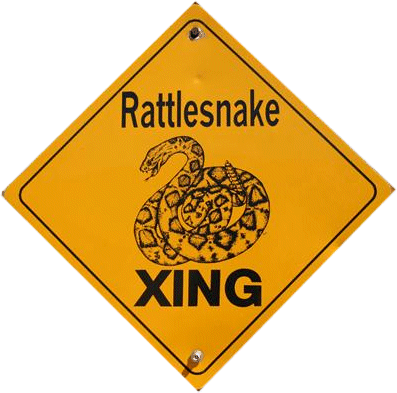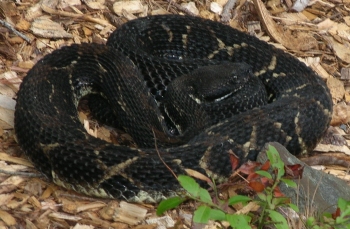
 Timber Rattlesnake Warning
Timber Rattlesnake Warning
The Organising Committee has been informed of the potential presence of crotalus horridus or timber rattlesnakes in the vicinity of the Stragapalooza 2010 Camp Site. Many thanks to our resident Health & Safety Consultant, Dr "Hanover" Bob Stragnell for bringing this to our attention.
In recent years snakes have been seen all over the Stragapalooza Camp Site and the resident Game Warden, Sanford Stragnell, has had to dispatch two such snakes so far this season. All participants should be aware of the possibility of encountering such creatures during the Stragapalooza festivities.
A timber rattlesnake next to Grandma's Ramp at the Ritz |
The timber rattlesnake, crotalus horridus, is a venomous snake found in woodland of the eastern United States and south-east Canada. This rattlesnake normally has dark colored bands on its body and a dark, often black, tail.
Potentially, this is one of North America's most dangerous snakes, due to its long fangs, impressive size and high venom yield. Fortunately, this is to some degree offset by its relatively mild disposition. Before striking, they often do a good deal of preliminary rattling and feinting. The timber rattler uses hunting techniques similar to the sidewinder rattlesnake. The timber snake tries to ambush its prey by lying motionless waiting for potential victims to pass by.
Rattlesnakes are cold-blooded, carnivorous and venomous reptiles found in North and South America. The snakes are noted for their different patterns and skin colors, triangle-shaped heads and tails with rattles. The snakes mainly prey on rodents, but approximately 800 people are bitten by rattlesnakes in the United States each year. Understanding rattlesnake warning signs can keep you from becoming another bite statistic.

Rattle Sound
As the name implies, rattlesnakes are equipped with rattles at the tips of their tails. The rattle is composed of several pieces of molted skin. When the reptile is disturbed and may attack, it shakes the end of its tail in a way that makes these hardened pieces of skin rattle. While the rattling sound is an indication that the rattlesnake is upset, these reptiles may also strike without producing the sound.
Coiled Position
Before attacking, a rattlesnake generally will keep its guard up by entering a coiled position. If you see a coiled snake, be wary. The snake feels threatened or provoked. Keep in mind that you have some safety barrier, as a rattlesnake can only strike half of its entire body length. If the rattler is not threatened by you, it will often withdraw, rather than strike. Never approach a coiled rattlesnake.
Fangs
When a rattlesnake displays its curved fangs, it is about to strike with a poisonous bite. An adult rattler can direct the amount of poison in a bite and will modify the quantity depending on the scenario. When a rattlesnake opens its mouth, the fangs are turned down at a 90-degree angle. The venom glands are located in the back of the rattler's head.
If You Come Across a Rattlesnake
Move out of the way. If you do walk into the range of a rattlesnake, calmly back off as quickly and quietly as you can. Contact the resident Game Warden, Sanford Stragnell, as soon as possible who will arrive within moments carrying large quantities of weapons of destruction.
Do not provoke a rattlesnake - let Sandy do that for you. Angering a snake will result in one response - you become its target. Remember - a snake is defending itself from attack in such a case and if you poke it with sticks, throw stones at it, kick at it or do silly little jigs around it, you are asking for trouble. And worse still, there may well be a difference in the venom between an angered rattlesnake and one reacting quickly in self-defence - the toxicity may be increased, whereas a surprised rattlesnake may only bite without injecting venom (possible, but by no means certain). Whatever the strength of the venom, an angered rattlesnake will be more likely to keep striking.
Leave the snake alone. Many people are bitten in the process of trying to heroically rid the world of one more bothersome snake. Apart from the snake not being bothersome, the snake is going to bite you to try and defend itself. Live and let live - back off and let it have its space to slither away. And be warned - there is a reason for the saying "as mad as a cut snake" - an injured snake is a very, very dangerous foe.
Back to Stragapalooza
Back to Greg's Temporary Home Page
